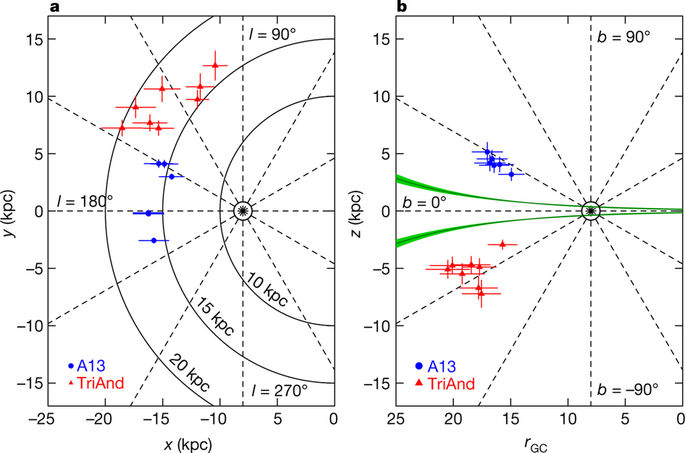Our official English website, www.x-mol.net, welcomes your
feedback! (Note: you will need to create a separate account there.)
Two chemically similar stellar overdensities on opposite sides of the plane of the Galactic disk
Nature ( IF 50.5 ) Pub Date : 2018-02-26 , DOI: 10.1038/nature25490 Maria Bergemann , Branimir Sesar , Judith G. Cohen , Aldo M. Serenelli , Allyson Sheffield , Ting S. Li , Luca Casagrande , Kathryn V. Johnston , Chervin F. P. Laporte , Adrian M. Price-Whelan , Ralph Schönrich , Andrew Gould
Nature ( IF 50.5 ) Pub Date : 2018-02-26 , DOI: 10.1038/nature25490 Maria Bergemann , Branimir Sesar , Judith G. Cohen , Aldo M. Serenelli , Allyson Sheffield , Ting S. Li , Luca Casagrande , Kathryn V. Johnston , Chervin F. P. Laporte , Adrian M. Price-Whelan , Ralph Schönrich , Andrew Gould

|
Our Galaxy is thought to have an active evolutionary history, dominated over the past ten billion years or so by star formation, the accretion of cold gas and, in particular, the merging of clumps of baryonic and dark matter. The stellar halo—the faint, roughly spherical component of the Galaxy—reveals rich ‘fossil’ evidence of these interactions, in the form of stellar streams, substructures and chemically distinct stellar components. The effects of interactions with dwarf galaxies on the content and morphology of the Galactic disk are still being explored. Recent studies have identified kinematically distinct stellar substructures and moving groups of stars in our Galaxy, which may have extragalactic origins. There is also mounting evidence that stellar overdensities (regions with greater-than-average stellar density) at the interface between the outer disk and the halo could have been caused by the interaction of a dwarf galaxy with the disk. Here we report a spectroscopic analysis of 14 stars from two stellar overdensities, each lying about five kiloparsecs above or below the Galactic plane—locations suggestive of an association with the stellar halo. We find that the chemical compositions of these two groups of stars are almost identical, both within and between these overdensities, and closely match the abundance patterns of stars in the Galactic disk. We conclude that these stars came from the disk, and that the overdensities that they are part of were created by tidal interactions of the disk with passing or merging dwarf galaxies.
中文翻译:

银盘平面两侧的两个化学性质相似的恒星密度过高
我们的银河系被认为具有活跃的演化历史,在过去 100 亿年左右的时间里,主要是恒星形成、冷气体的吸积,尤其是重子和暗物质团块的合并。恒星晕——银河系中微弱的、大致呈球形的部分——以恒星流、子结构和化学上不同的恒星成分的形式,揭示了这些相互作用的丰富“化石”证据。与矮星系相互作用对银盘内容和形态的影响仍在探索中。最近的研究已经确定了我们银河系中运动学上不同的恒星亚结构和移动的恒星群,它们可能起源于河外。还有越来越多的证据表明,外盘和晕之间界面处的恒星密度过高(恒星密度高于平均水平的区域)可能是由矮星系与盘的相互作用引起的。在这里,我们报告了对来自两个恒星密度过高的 14 颗恒星的光谱分析,每颗恒星都位于银河平面上方或下方约 5 千秒差距处——这些位置暗示着与恒星晕的关联。我们发现这两组恒星的化学成分在这些超密度内部和之间几乎相同,并且与银盘中恒星的丰度模式密切匹配。我们得出结论,这些恒星来自圆盘,它们所属的超密度是由圆盘与经过或合并的矮星系的潮汐相互作用造成的。
更新日期:2018-02-26
中文翻译:

银盘平面两侧的两个化学性质相似的恒星密度过高
我们的银河系被认为具有活跃的演化历史,在过去 100 亿年左右的时间里,主要是恒星形成、冷气体的吸积,尤其是重子和暗物质团块的合并。恒星晕——银河系中微弱的、大致呈球形的部分——以恒星流、子结构和化学上不同的恒星成分的形式,揭示了这些相互作用的丰富“化石”证据。与矮星系相互作用对银盘内容和形态的影响仍在探索中。最近的研究已经确定了我们银河系中运动学上不同的恒星亚结构和移动的恒星群,它们可能起源于河外。还有越来越多的证据表明,外盘和晕之间界面处的恒星密度过高(恒星密度高于平均水平的区域)可能是由矮星系与盘的相互作用引起的。在这里,我们报告了对来自两个恒星密度过高的 14 颗恒星的光谱分析,每颗恒星都位于银河平面上方或下方约 5 千秒差距处——这些位置暗示着与恒星晕的关联。我们发现这两组恒星的化学成分在这些超密度内部和之间几乎相同,并且与银盘中恒星的丰度模式密切匹配。我们得出结论,这些恒星来自圆盘,它们所属的超密度是由圆盘与经过或合并的矮星系的潮汐相互作用造成的。











































 京公网安备 11010802027423号
京公网安备 11010802027423号